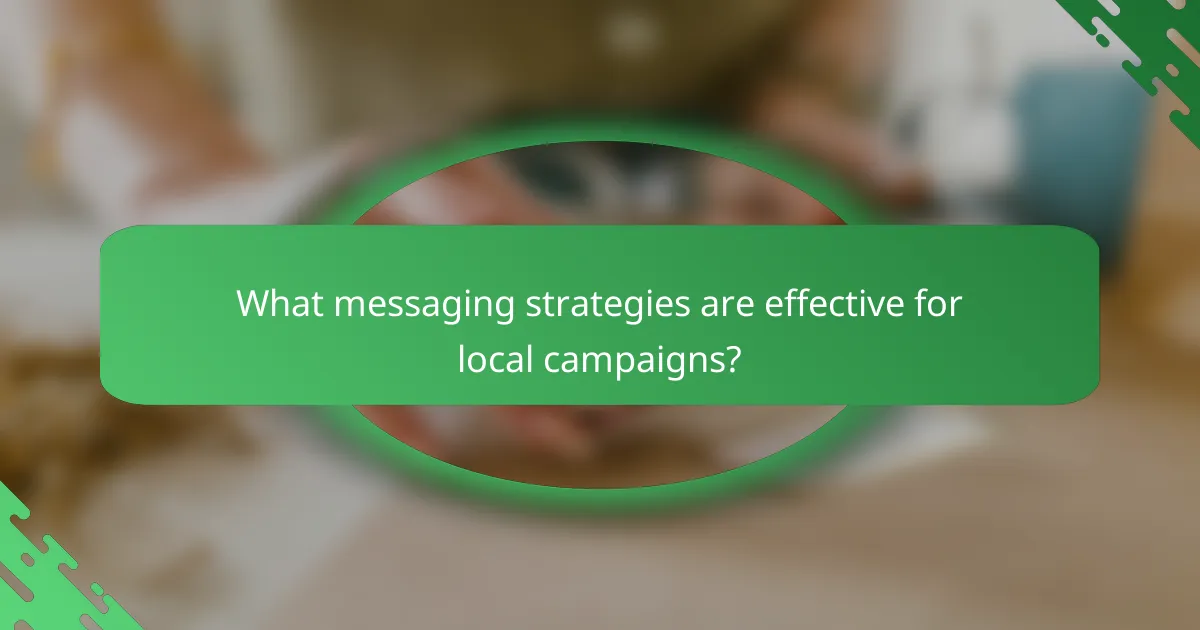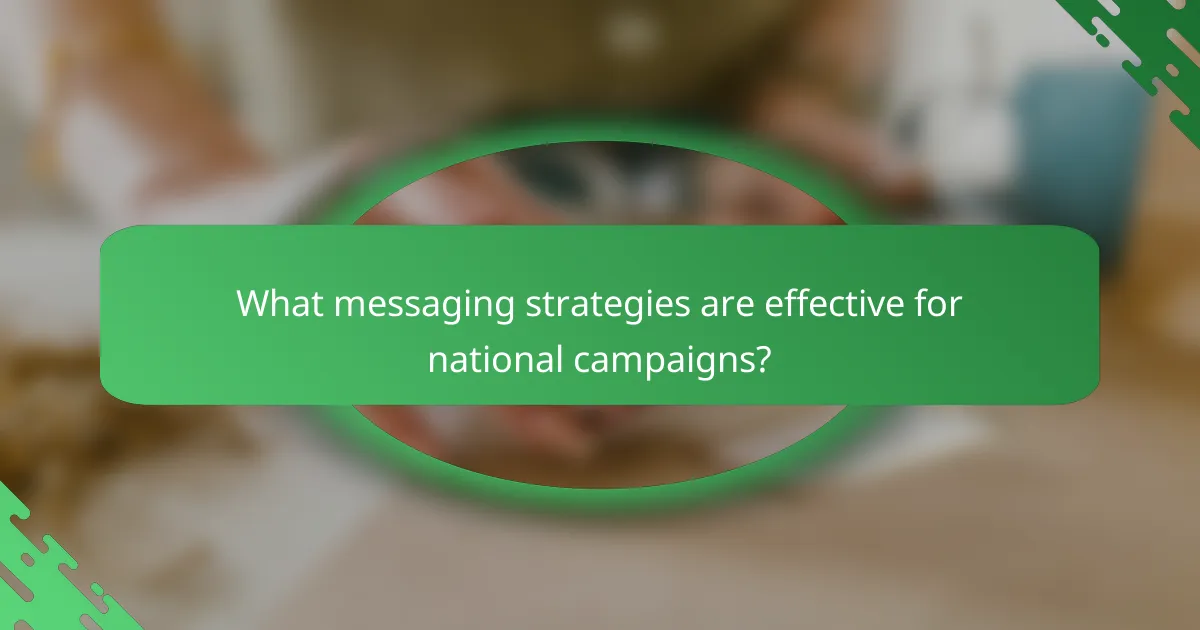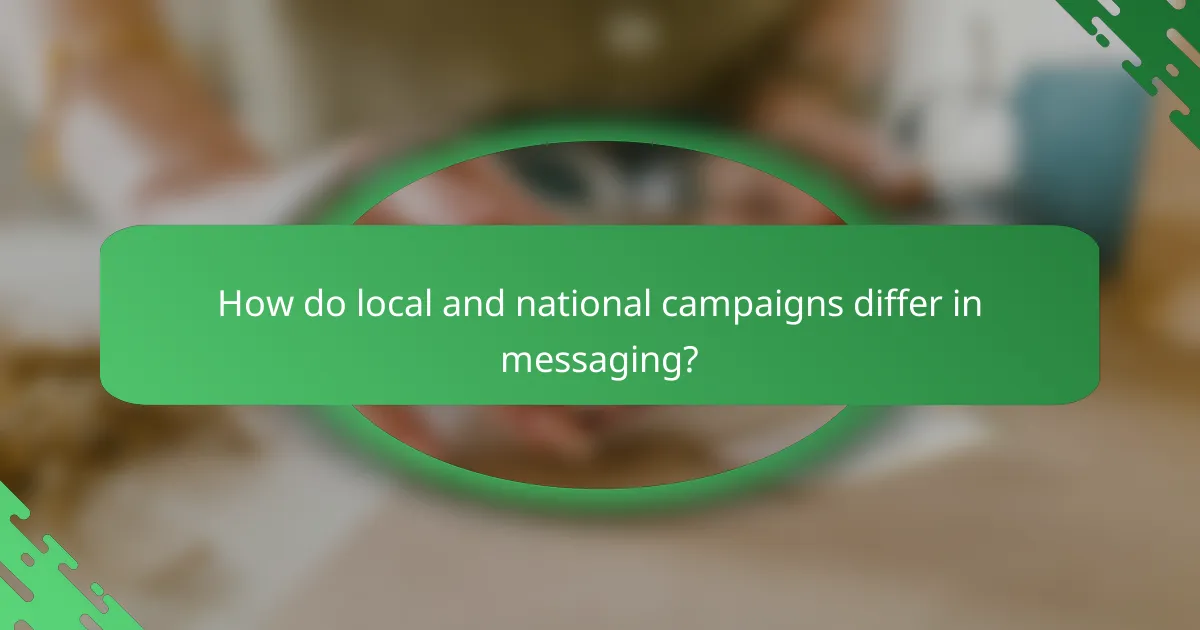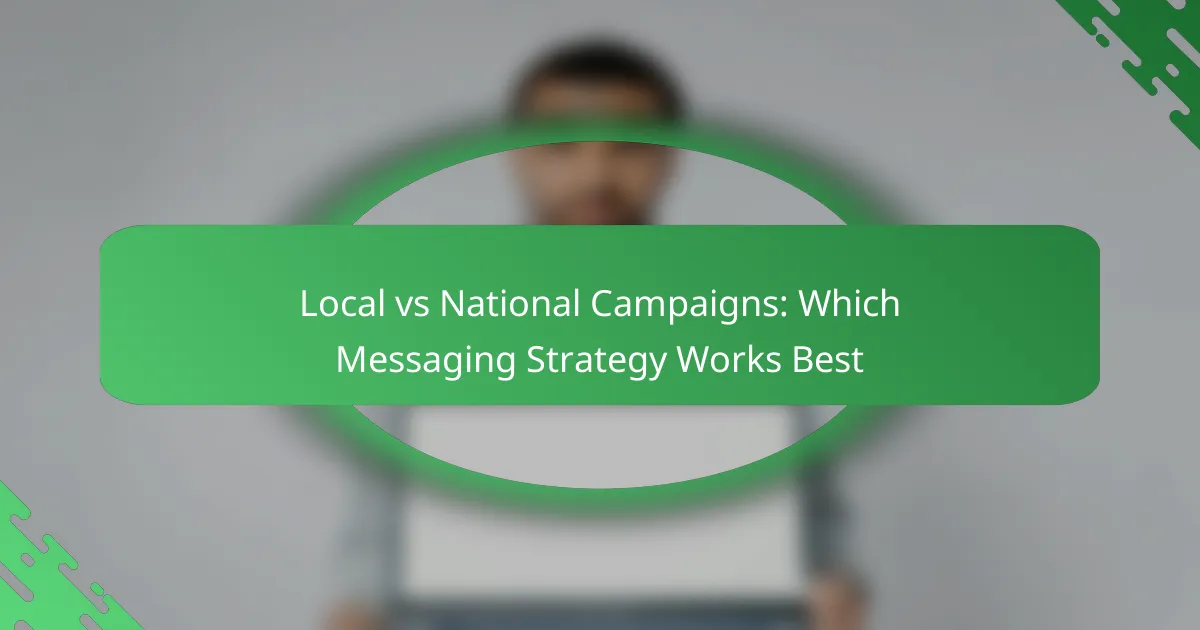When it comes to campaigning, the choice between local and national strategies hinges on the target audience and messaging approach. Local campaigns thrive on community relevance and direct engagement, fostering strong connections with residents, while national campaigns prioritize broad reach and brand consistency through mass media and data-driven tactics. Understanding these differences is crucial for optimizing engagement and achieving campaign goals.

What messaging strategies are effective for local campaigns?
Effective messaging strategies for local campaigns focus on community relevance, direct engagement, and tailored content. These strategies help create a strong connection with the local audience, enhancing the impact of the campaign.
Community engagement tactics
Community engagement tactics involve actively involving local residents in the campaign process. This can include hosting town hall meetings, participating in local events, or collaborating with community organizations to foster trust and credibility.
Utilizing surveys or feedback forms can also help gauge community interests and concerns, allowing for more tailored messaging. Engaging with local influencers can amplify reach and enhance authenticity.
Localized content creation
Localized content creation focuses on developing materials that resonate with the specific cultural and social dynamics of the community. This can include using local dialects, referencing regional events, or highlighting local success stories.
For example, a campaign in a coastal town might emphasize marine conservation efforts, while one in a rural area could focus on agricultural initiatives. This relevance increases the likelihood of engagement and support from the local audience.
Targeted social media advertising
Targeted social media advertising allows campaigns to reach specific demographics within a local area. Platforms like Facebook and Instagram offer tools to define audiences based on location, interests, and behaviors, making it easier to tailor messages.
For instance, a local restaurant could promote a special event to users within a certain radius, ensuring the message reaches potential customers. Regularly analyzing ad performance can help refine strategies and improve engagement rates.
Local SEO optimization
Local SEO optimization is crucial for ensuring that a campaign appears in relevant local searches. This involves optimizing website content with local keywords, creating Google My Business listings, and encouraging customer reviews.
For example, a small business should include its city or neighborhood in website metadata and blog posts to enhance visibility. Regularly updating content and maintaining accurate business information can significantly improve search rankings and attract local customers.

What messaging strategies are effective for national campaigns?
Effective messaging strategies for national campaigns focus on reaching a broad audience while maintaining brand consistency. These strategies leverage mass media advertising and data-driven audience segmentation to optimize engagement and conversion rates.
Broad audience targeting
Broad audience targeting is essential for national campaigns, as it allows brands to reach a diverse demographic across various regions. This approach often involves creating generalized messaging that resonates with a wide range of consumers, ensuring that key themes and values are universally appealing.
To implement broad audience targeting, consider using insights from previous campaigns to identify common interests and behaviors. This can help in crafting messages that connect with a larger audience, increasing overall campaign effectiveness.
Brand consistency across channels
Maintaining brand consistency across all channels is crucial for national campaigns. This means using the same logos, colors, and messaging tone in advertisements, social media, and other platforms to reinforce brand identity.
Inconsistent branding can confuse potential customers and dilute the campaign’s impact. To ensure consistency, create a brand guideline document that outlines how to present the brand across different media, making it easier for teams to adhere to the established standards.
Mass media advertising
Mass media advertising plays a pivotal role in national campaigns by reaching large audiences quickly. This includes television, radio, print, and digital platforms, which can effectively disseminate messages to millions of viewers or listeners simultaneously.
When planning mass media advertising, consider the timing and placement of ads to maximize visibility. For instance, airing commercials during peak viewing hours or placing ads in widely read publications can significantly enhance reach and engagement.
Data-driven audience segmentation
Data-driven audience segmentation involves analyzing consumer data to identify specific groups within the broader audience. This allows for tailored messaging that speaks directly to the interests and needs of different segments, improving the chances of conversion.
Utilize tools like customer relationship management (CRM) software and analytics platforms to gather insights on demographics, purchasing behaviors, and preferences. This data can inform targeted campaigns that resonate more deeply with each segment, leading to higher engagement rates and better overall performance.

How do local and national campaigns differ in messaging?
Local and national campaigns differ primarily in their target audience and messaging strategies. Local campaigns focus on community-specific issues and cultural nuances, while national campaigns aim for broader appeal across diverse demographics.
Audience reach and engagement
Local campaigns typically engage a smaller, more targeted audience, often resulting in higher engagement rates. This is due to the tailored messaging that resonates with community values and concerns, leading to stronger connections.
In contrast, national campaigns seek to reach a larger audience, which can dilute engagement as the messaging must appeal to a wider range of interests. While the potential reach is vast, the challenge lies in maintaining relevance across different regions.
Cultural relevance and tone
Cultural relevance is crucial for local campaigns, as they often incorporate local dialects, traditions, and issues that matter to the community. This localized approach fosters trust and relatability, making the messaging more effective.
National campaigns, however, must adopt a more generalized tone that can resonate with various cultural backgrounds. This can sometimes lead to a lack of depth in addressing specific local issues, which may alienate certain segments of the audience.
Budget allocation and ROI
Budget allocation for local campaigns tends to focus on grassroots efforts, such as community events and local media, which can yield high returns on investment (ROI) due to the targeted nature of the outreach. Costs can vary widely but are often manageable within local budgets.
National campaigns usually require larger budgets for extensive media buys and broader outreach strategies. While the potential ROI can be significant, it often comes with higher risks and the need for careful analysis to ensure that the investment translates into measurable results.

What factors should businesses consider when choosing a campaign type?
Businesses should consider their target audience, marketing budget, and overall goals when deciding between local and national campaigns. Each factor significantly influences the effectiveness and reach of the chosen messaging strategy.
Target audience demographics
Understanding the demographics of your target audience is crucial in selecting the right campaign type. Local campaigns are often more effective for businesses targeting specific communities or regions, while national campaigns can reach broader audiences across diverse demographics.
Consider factors such as age, gender, income level, and interests. For example, a local bakery may benefit from a community-focused campaign, while a tech company might opt for a national strategy to appeal to a wider range of consumers.
Marketing budget and resources
Your marketing budget and available resources will heavily influence your campaign type. Local campaigns typically require lower budgets and can utilize grassroots marketing techniques, while national campaigns usually demand larger investments in media and advertising.
Evaluate your financial capacity and human resources. If your budget is limited, focus on local outreach strategies like community events or social media targeting specific areas. For larger budgets, consider national advertising channels such as television or online platforms that reach a wider audience.
Business goals and objectives
Your business goals and objectives play a vital role in determining the appropriate campaign type. If your aim is to build brand awareness in a specific locality, a local campaign may be more effective. Conversely, if you seek to expand your brand’s reach across the country, a national campaign is likely the better choice.
Clearly define what you want to achieve. For instance, if your goal is to increase sales in a particular region, focus on localized promotions. If you want to launch a new product nationwide, invest in a comprehensive national marketing strategy that can generate buzz across multiple platforms.

What are the advantages of local campaigns?
Local campaigns offer several advantages, including stronger community ties and tailored messaging that resonates with specific audiences. By focusing on local needs and preferences, businesses can enhance engagement and drive customer loyalty.
Higher customer loyalty
Local campaigns tend to foster higher customer loyalty because they connect with consumers on a personal level. When businesses engage with their communities through localized messaging, they create a sense of belonging and trust that national campaigns often lack.
For example, a local coffee shop that highlights its support for nearby schools or charities can build a loyal customer base. Customers are more likely to return when they feel their patronage directly benefits their community.
To enhance customer loyalty, consider using local influencers or hosting community events. These strategies can deepen relationships and encourage repeat business, making your brand a staple in the local area.
